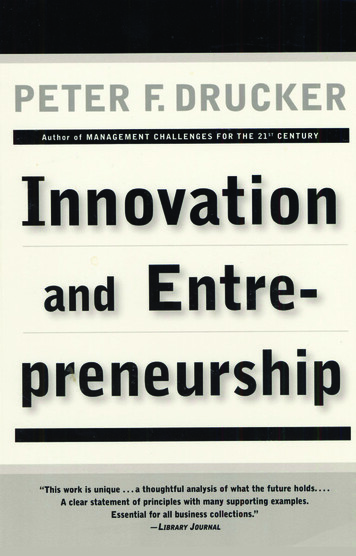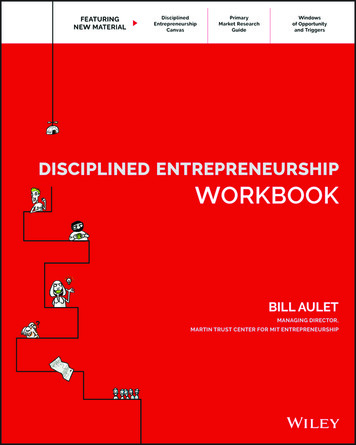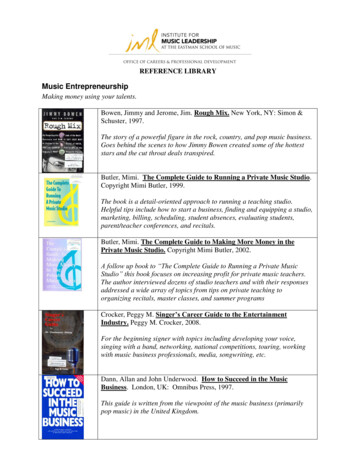
Transcription
53231 Innovation and Entrepreneurship.qxd11/8/200210:50 AMPage iPETER F. DRUCKERINNOVATIONAND ENTREPRENEURSHIPPractice andPrinciples
53231 Innovation and Entrepreneurship.qxd11/8/200210:50 AMPage ii
53231 Innovation and Entrepreneurship.qxd11/8/200210:50 AMPage iiiContentsPrefaceviiIntroduction: The Entrepreneurial EconomyI.19THE PRACTICE OF INNOVATION1. Systematic Entrepreneurship2. Purposeful Innovation and the Seven Sources forInnovative Opportunity3. Source: The Unexpected4. Source: Incongruities5. Source: Process Need6. Source: Industry and Market Structures7. Source: Demographics8. Source: Changes in Perception9. Source: New Knowledge10. The Bright Idea11. Principles of InnovationII.THE PRACTICE OF ENTREPRENEURSHIP12.13.14.15.1Entrepreneurial ManagementThe Entrepreneurial BusinessEntrepreneurship in the Service InstitutionThe New Venturev2130375769768899107130133141143147177188
53231 Innovation and Entrepreneurship.qxdviIII.11/8/200210:50 AMPage ivCONTENTSENTREPRENEURIAL STRATEGIES16. “Fustest with the Mostest”17. “Hit Them Where They Ain’t”18. Ecological Niches19. Changing Values and Characteristics207209220233243Conclusion: The Entrepreneurial Society253Suggested Readings267Index269About the AuthorBooks by Peter F. DruckerCreditsCopyrightAbout the Publisher
53231 Innovation and Entrepreneurship.qxd11/8/200210:50 AMPage vPrefaceThis book presents innovation and entrepreneurship as a practice anda discipline. It does not talk of the psychology and the character traitsof entrepreneurs; it talks of their actions and behavior. It uses cases,but primarily to exemplify a point, a rule, or a warning, rather than assuccess stories. The work thus differs, in both intention and execution, from many of the books and articles on innovation and entrepreneurship that are being published today. It shares with them thebelief in the importance of innovation and entrepreneurship. Indeed,it considers the emergence of a truly entrepreneurial economy in theUnited States during the last ten to fifteen years the most significantand hopeful event to have occurred in recent economic and social history. But whereas much of today’s discussion treats entrepreneurshipas something slightly mysterious, whether gift, talent, inspiration, or“flash of genius,” this book represents innovation and entrepreneurship as purposeful tasks that can be organized—are in need of beingorganized—and as systematic work. It treats innovation and entrepreneurship, in fact, as part of the executive’s job.This is a practical book, but it is not a “how-to” book. Instead, itdeals with the what, when, and why; with such tangibles as policiesand decisions; opportunities and risks; structures and strategies;staffing, compensation, and rewards.Innovation and entrepreneurship are discussed under three mainheadings: The Practice of Innovation; The Practice ofEntrepreneurship; and Entrepreneurial Strategies. Each of these is an“aspect” of innovation and entrepreneurship rather than a stage.Part I on the Practice of Innovation presents innovation alike aspurposeful and as a discipline. It shows first where and how the entrepreneur searches for innovative opportunities. It then discusses thevii
53231 Innovation and Entrepreneurship.qxdviii11/8/200210:50 AMPage viPREFACEDo’s and Dont’s of developing an innovative idea into a viable business or service.Part II, The Practice of Entrepreneurship, focuses on the institution that is the carrier of innovation. It deals with entrepreneurialmanagement in three areas: the existing business; the public-serviceinstitution; and the new venture. What are the policies and practicesthat enable an institution, whether business or public-service, to be asuccessful entrepreneur? How does one organize and staff for entrepreneurship? What are the obstacles, the impediments, the traps, thecommon mistakes? The section concludes with a discussion of individual entrepreneurs, their roles and their decisions.Finally, Part III, Entrepreneurial Strategies, talks of bringing aninnovation successfully to market. The test of an innovation, after all,lies not its novelty, its scientific content, or its cleverness. It lies in itssuccess in the marketplace.These three parts are flanked by an Introduction that relates innovation and entrepreneurship to the economy, and by a Conclusion thatrelates them to society.Entrepreneurship is neither a science nor an art. It is a practice. Ithas a knowledge base, of course, which this book attempts to presentin organized fashion. But as in all practices, medicine, for instance, orengineering, knowledge in entrepreneurship is a means to an end.Indeed, what constitutes knowledge in a practice is largely defined bythe ends, that is, by the practice. Hence a book like this should bebacked by long years of practice.My work on innovation and entrepreneurship began thirty yearsago, in the mid-fifties. For two years, then, a small group met undermy leadership at the Graduate Business School of New YorkUniversity every week for a long evening’s seminar on Innovationand Entrepreneurship. The group included people who were justlaunching their own new ventures, most of them successfully. Itincluded mid-career executives from a wide variety of established,mostly large organizations: two big hospitals; IBM and GeneralElectric; one or two major banks; a brokerage house; magazine andbook publishers; pharmaceuticals; a worldwide charitable organization; the Catholic Archdiocese of New York and the PresbyterianChurch; and so on.The concepts and ideas developed in this seminar were tested byits members week by week during those two years in their own work
53231 Innovation and Entrepreneurship.qxdPreface11/8/200210:50 AMPage viiixand their own institutions. Since then they have been tested, validated, refined, and revised in more than twenty years of my own consulting work. Again, a wide variety of institutions has been involved.Some were businesses, including high-tech ones such as pharmaceuticals and computer companies; “no-tech” ones such as casualtyinsurance companies; “world-class” banks, both American andEuropean; one-man startup ventures; regional wholesalers of buildingproducts; and Japanese multinationals. But a host of “nonbusinesses”also were included: several major labor unions; major communityorganizations such as the Girl Scouts of the U.S.A. or C.A.R.E., theinternational relief and development cooperative; quite a few hospitals; universities and research labs; and religious organizations froma diversity of denominations.Because this book distills years of observation, study, and practice, I was able to use actual “mini-cases,” examples and illustrationsboth of the right and the wrong policies and practices. Wherever thename of an institution is mentioned in the text, it has either never beena client of mine (e.g., IBM) and the story is in the public domain, orthe institution itself has disclosed the story. Otherwise organizationswith whom I have worked remain anonymous, as has been my practice in all my management books. But the cases themselves reportactual events and deal with actual enterprises.Only in the last few years have writers on management begun topay much attention to innovation and entrepreneurship. I have beendiscussing aspects of both in all my management books for decades.Yet this is the first work that attempts to present the subject in itsentirety and in systematic form. This is surely a first book on a majortopic rather than the last word—but I do hope it will be accepted as aseminal work.Claremont, CaliforniaChristmas 1984
53231 Innovation and Entrepreneurship.qxd11/8/200210:50 AMPage viii
53231 Innovation and Entrepreneurship.qxd11/8/200210:50 AMPage 1Introduction:The Entrepreneurial EconomyISince the mid-seventies, such slogans as “the no-growth economy,”the “deindustrialization of America,” and a long-term “Kondratieffstagnation of the economy” have become popular and are invoked asif axioms. Yet the facts and figures belie every one of these slogans.What is happening in the United States is something quite different: aprofound shift from a “managerial” to an “entrepreneurial” economy.In the two decades 1965 to 1985, the number of Americans oversixteen (thereby counted as being in the work force under the conventions of American statistics) grew by two-fifths, from 129 to 180million. But the number of Americans in paid jobs grew in the sameperiod by one-half, from 71 to 106 million. The labor force growthwas fastest in the second decade of that period, the decade from 1974to 1984, when total jobs in the American economy grew by a full 24million.In no other peacetime period has the United States created asmany new jobs, whether measured in percentages or in absolute numbers. And yet the ten years that began with the “oil shock” in the latefall of 1973 were years of extreme turbulence, of “energy crises,” ofthe near-collapse of the “smokestack” industries, and of two sizablerecessions.The American development is unique. Nothing like it has happenedyet in any other country. Western Europe during the period 1970 to1984 actually lost jobs, 3 to 4 million of them. In 1970, western Europestill had 20 million more jobs than the United States; in 1984, it hadalmost 10 million less. Even Japan did far less well in job creation thanthe United States. During the twelve years from 1970 through 1982,1
53231 Innovation and Entrepreneurship.qxd211/8/200210:50 AMPage 2INTRODUCTION: THE ENTREPRENEURIAL ECONOMYjobs in Japan grew by a mere 10 percent, that is, at less than half theU.S. rate.But America’s performance in creating jobs during the seventiesand early eighties also ran counter to what every expert had predicted twenty-five years ago. Then most labor force analysts expected theeconomy, even at its most rapid growth, to be unable to provide jobsfor all the boys of the “baby boom” who were going to reach working age in the seventies and early eighties—the first large cohorts of“baby boom” babies having been born in 1949 and 1950. Actually,the American economy had to absorb twice that number. For—something nobody even dreamed of in 1970—married women began torush into the labor force in the mid-seventies. The result is that today,in the mid-eighties, every other married woman with young childrenholds a paid job, whereas only one out of every five did so in 1970.And the American economy found jobs for these, too, in many casesfar better jobs than women had ever held before.And yet “everyone knows” that the seventies and early eightieswere periods of “no growth,” of stagnation and decline, of a “deindustrializing America,” because everyone still focuses on what werethe growth areas in the twenty-five years after World War II, the yearsthat came to an end around 1970.In those earlier years, America’s economic dynamics centered ininstitutions that were already big and were getting bigger: the Fortune500, that is, the country’s largest businesses; governments, whetherfederal, state, or local; the large and super-large universities; the largeconsolidated high school with its six thousand or more students; andthe large and growing hospital. These institutions created practicallyall the new jobs provided in the American economy in the quartercentury after World War II. And in every recession during this period,job loss and unemployment occurred predominantly in small institutions and, of course, mainly in small businesses.But since the late 1960s, job creation and job growth in theUnited States have shifted to a new sector. The old job creatorshave actually lost jobs in these last twenty years. Permanentjobs (not counting recession unemployment) in the Fortune 500have been shrinking steadily year by year since around 1970, atfirst slowly, but since 1977 or 1978 at a pretty fast clip. By1984, the Fortune 500 had lost permanently at least 4 to 6 million jobs. And governments in America, too, now employ fewerpeople than they did ten or fifteen years ago, if only because the
53231 Innovation and Entrepreneurship.qxd11/8/200210:50 AMPage 3Introduction3number of schoolteachers has been falling as school enrollmentdropped in the wake of the “baby bust” of the early sixties.Universities grew until 1980; since then, employment there has beendeclining. And in the early eighties, even hospital employmentstopped increasing. In other words, we have not in fact created 35million new jobs; we have created 40 million or more, since we hadto offset a permanent job shrinkage of at least 5 million jobs in thetraditional employing institutions. And all these new jobs must havebeen created by small and medium-sized institutions, most of themsmall and medium-sized businesses, and a great many of them, if notthe majority, new businesses that did not even exist twenty years ago.According to The Economist, 600,000 new businesses are being started in the United States every year now—about seven times as manyas were started in each of the boom years of the fifties and sixties.II“Ah,” everybody will say immediately, “high tech.” But things are notquite that simple. Of the 40 million-plus jobs created since 1965 in theeconomy, high technology did not contribute more than 5 or 6 million.High tech thus contributed no more than “smokestack” lost. All theadditional jobs in the economy were generated elsewhere. And only oneor two out of every hundred new businesses—a total of ten thousand ayear—are remotely “high-tech,” even in the loosest sense of the term.We are indeed in the early stages of a major technologicaltransformation, one that is far more sweeping than the most ecstatic of the “futurologists” yet realize, greater even than Megatrendsor Future Shock. Three hundred years of technology came to anend after World War II. During those three centuries the model fortechnology was a mechanical one: the events that go on inside astar such as the sun. This period began when an otherwise almostunknown French physicist, Denis Papin,* envisaged the steamengine around 1680. They ended when we replicated in thenuclear explosion the events inside a star. For these three centuriesadvance in technology meant—as it does in mechanical processes—more speed, higher temperatures, higher pressures. Since theend of World War II, however, the model of technology*The dates of all persons mentioned in the test will be found in the index
53231 Innovation and Entrepreneurship.qxd411/8/200210:50 AMPage 4INTRODUCTION: THE ENTREPRENEURIAL ECONOMYhas become the biological process, the events inside an organism.And in an organism, processes are not organized around energy in thephysicist’s meaning of the term. They are organized around information.There is no doubt that high tech, whether in the form of computers or telecommunication, robots on the factory floor or officeautomation, biogenetics or bioengineering, is of immeasurable qualitative importance. High tech provides the excitement and the headlines. It creates the vision for entrepreneurship and innovation in thecommunity, and the receptivity for them. The willingness of young,highly trained people to go to work for small and unknown employers rather than for the giant bank or the worldwide electrical equipment maker is surely rooted in the mystique of “high tech”—eventhough the overwhelming majority of these young people work foremployers whose technology is prosaic and mundane. High tech alsoprobably stimulated the astonishing transformation of the Americancapital market from near-absence of venture capital as recently as themid-sixties to near-surplus in the mid-eighties. High tech is thus whatthe logicians used to call the ratio cognoscendi, the reason why weperceive and understand a phenomenon rather than the explanation ofits emergence and the cause of its existence.Quantitatively, as has already been said, high tech is quite smallstill, accounting for not much more than one-eighth of the new jobs.Nor will it become much more important in terms of new jobs within the near future. Between now and the year 2000, no more than onesixth of the jobs we can expect to create in the American economywill be high-tech jobs in all likelihood. In fact, if high tech were, asmost people think, the entrepreneurial sector of the U.S. economy,then we would indeed face a “no-growth” period and a period oflong-term stagnation in the trough of a “Kondratieff wave.”The Russian economist Nikolai Kondratieff was executed on Stalin’sorders in the mid-1930s because his econometric model predicted, accurately as it turned out, that collectivization of Russian agriculture wouldlead to a sharp decline in farm production. The “fifty-year Kondratieffcycle” was based on the inherent dynamics of technology. Every fiftyyears, so Kondratieff asserted, a long technological wave crests. For thelast twenty years of this cycle, the growth industries of the last technological advance seem to be doing exceptionally well. But what look likerecord profits are actually repayments of capital which is no longerneeded in industries that have ceased to grow. This situa
53231 Innovation and Entrepreneurship.qxd11/8/2002Introduction10:50 AMPage 55tion never lasts longer than twenty years, then there is a sudden crisis,usually signaled by some sort of panic. There follow twenty years ofstagnation, during which the new, emerging technologies cannot generate enough jobs to make the economy itself grow again—and no one,least of all government, can do much about this.*The industries that fueled the long economic expansion after World WarII—automobiles, steel, rubber, electrical apparatus, consumer electronics,telephone, but also petroleum†—perfectly fit the Kondratieff cycle.Technologically, all of them go back to the fourth quarter of the nineteenthcentury or, at the very latest, to before World War I. In none of them has therebeen a significant breakthrough since the 1920s, whether in technology or inbusiness concepts. When the economic growth began after World War II,they were all thoroughly mature industries. They could expand and createjobs with relatively little new capital investment, which explains why theycould pay skyrocketing wages and workers’ benefits and simultaneouslyshow record profits. Yet, as Kondratieff had predicted, these signs of robusthealth were as deceptive as the flush on a consumptive’s cheek. The industries were corroding from within. They did not become stagnant or declineslowly. Rather, they collapsed as soon as the “oil shocks” of 1973 and 1979dealt them the first blows. Within a few years they went from record profitsto near-bankruptcy. As soon became abundantly clear, they will not be ableto return to their earlier employment levels for a long time, if ever.The high-tech industries, too, fit Kondratieff’s theory. As Kondratieffhad predicted, they have so far not been able to generate more jobs thanthe old industries have been losing. All projections indicate that they willnot do much more for long years to come, at least for the rest of the century. Despite the explosive growth of computers, for instance, data processing and information handling in all their phases (design and engineering of both hardware and software, production, sales and ser*Kondratjeff’s long-wave cycle was popularized in the West by the AustroAmerican economist Joseph Schumpeter, in his monumental book Business Cycles(1939). Kondratieff’s best known, most serious, and most important disciple today—and also the most serious and most knowledgeable of the prophets of “long-termstagnation”—is the MIT scientist Jay Forrester.† Which, contrary to common belief, was the first one to start declining. In fact,petroleum ceased to be a growth industry around 1950. Since then the incrementalunit of petroleum needed for an additional unit of output, whether in manufacturing,in transportation, or in heating and air conditioning, has been falling—slowly at firstbut rapidly since 1973.
53231 Innovation and Entrepreneurship.qxd611/8/200210:50 AMPage 6INTRODUCTION: THE ENTREPRENEURIAL ECONOMYvice) are not expected to add as many jobs to the American economy inthe late 1980s and early 1990s as the steel and automotive industries arealmost certain to lose.But the Kondratieff theory fails totally to account for the 40 millionjobs which the American economy actually did create. Western Europe,to be sure, has so far been following the Kondratieff script. But not theUnited States, and perhaps not Japan either. Something in the UnitedStates offsets the Kondratieff “long wave of technology.” Somethinghas already happened that is incompatible with the theory of long-termstagnation.Nor does it appear at all likely that we have simply postponedthe Kondratieff cycle. For in the next twenty years the need to create new jobs in the U.S. economy will be a great deal lower than ithas been in the last twenty years, so that economic growth willdepend far less on job creation. The number of new entrants into theAmerican work force will be up to one-third smaller for the rest ofthe century—and indeed through the year 2010—than it was in theyears when the children of the “baby boom” reached adulthood, thatis, 1965 until 1980 or so. Since the “baby bust” of 1960–61, thebirth cohorts have been 30 percent lower than they were during the“baby boom” years. And with the labor force participation ofwomen under fifty already equal to that of men, additions to thenumber of women available for paid jobs will from now on be limited to natural growth, which means that they will also be down byabout 30 percent.For the future of the traditional “smokestack” industries, theKondratieff theory must be accepted as a serious hypothesis, if notindeed as the most plausible of the available explanations. And as faras the inability of new high-tech industries to offset the stagnation ofyesterday’s growth industries is concerned, Kondratieff againdeserves to be taken seriously. For all their tremendous qualitativeimportance as vision makers and pacesetters, quantitatively the hightech industries represent tomorrow rather than today, especially ascreators of jobs. They are the makers of the future rather than themakers of the present.But as a theory of the American economy that can explain itsbehavior and predict its direction, Kondratieff can be considered disproven and discredited. The 40 million new jobs created in the U.S.economy during a “Kondratieff long-term stagnation” cannot beexplained in Kondratieff’s terms.
53231 Innovation and Entrepreneurship.qxd11/8/2002Introduction10:50 AMPage 77I do not mean to imply that there are no economic problems or dangers. Quite the contrary. A major shift in the technological foundationsof the economy such as we are experiencing in the closing quarter ofthe twentieth century surely presents tremendous problems, economic, social, and political. We are also in the throes of a major politicalcrisis, the crisis of that great twentieth-century success the WelfareState, with the attendant danger of an uncontrolled and seeminglyuncontrollable but highly inflationary deficit. There is surely sufficientdanger in the international economy, with the world’s rapidly industrializing nations, such as Brazil or Mexico, suspended between rapideconomic takeoff and disastrous crash, to make possible a prolongedglobal depression of 1930 proportions. And then there is the frightening specter of the runaway armaments race. But at least one of thefears abroad these days, that of a Kondratieff stagnation, can be considered more a figment of the imagination than reality for the UnitedStates. There we have a new, an entrepreneurial economy.It is still too early to say whether the entrepreneurial economy willremain primarily an American phenomenon or whether it will emergein other industrially developed countries. In Japan, there is good reason to believe that it is emerging, albeit in its own, Japanese form. Butwhether the same shift to an entrepreneurial economy will occur inwestern Europe, no one can yet say. Demographically, westernEurope lags some ten to fifteen years behind America: both the “babyboom” and the “baby bust” came later in Europe than in the UnitedStates. Equally, the shift to much longer years of schooling started inwestern Europe some ten years later than in the United States or inJapan; and in Great Britain it has barely started yet. If, as is quite likely, demographics has been a factor in the emergence of the entrepreneurial economy in the United States, we could well see a similardevelopment in Europe by 1990 or 1995. But this is speculation. Sofar, the entrepreneurial economy is purely an American phenomenon.IIIWhere did all the new jobs come from? The answer is from anywhereand nowhere; in other words, from no one single source.The magazine Inc., published in Boston, has printed each year since1982 a list of the one hundred fastest-growing, publicly owned Americancompanies more than five years and less than fifteen years old.
53231 Innovation and Entrepreneurship.qxd811/8/200210:50 AMPage 8INTRODUCTION: THE ENTREPRENEURIAL ECONOMYBeing confined to publicly owned companies, the list is heavilybiased toward high tech, which has easy access to underwriters, tostock market money, and to being traded on one of the stockexchanges or over the counter. High tech is fashionable. Other newventures, as a rule, can go public only after long years of seasoning,and of showing profits for a good deal more than five years. Yet onlyone-quarter of the “Inc. 100” are high-tech; three-quarters remainmost decidedly “low-tech,” year after year.In 1982, for instance, there were five restaurant chains, twowomen’s wear manufacturers, and twenty health-care providers onthe list, but only twenty to thirty high-tech companies. And whilstAmerica’s newspapers in 1982 ran one article after the other bemoaning the “deindustrialization of America,” a full half of the Inc. firmswere manufacturing companies; only one-third were in services.Although word had it in 1982 that the Frost Belt was dying, with theSun Belt the only possible growth area, only one-third of the “inc.100” that year were in the Sun Belt. New York had as many of thesefast-growing, young, publicly owned companies as California orTexas. And Pennsylvania, New Jersey, and Massachusetts—whilesupposedly dying, if not already dead—also had as many asCalifornia or Texas, and as many as New York. Snowy, Minnesota,had seven. The Inc. lists for 1983 and 1984 showed a very similar distribution, in respect both to industry and to geography.In 1983, the first and second companies on another Inc. list—the“Inc. 500” list of fast-growing, young, privately held companies—were, respectively, a building contractor in the Pacific Northwest (ina year in which construction was supposedly at an all-time low) anda California manufacturer of physical exercise equipment for thehome.Any inquiry among venture capitalists yields the same pattern.Indeed, in their portfolios, high tech is usually even less prominent. The portfolio of one of the most successful venture capitalinvestors does include several high-tech companies: a new computer software producer, a new venture in medical technology, andso on. But the most profitable investment in this portfolio, the newcompany that has been growing the fastest in both revenues andprofitability during the three years 1981–83, is that most mundaneand least high-tech of businesses, a chain of barbershops. Andnext to it, both in sales growth and profitability, comes a chain ofdentistry offices, followed by a manufacturer of handtools
53231 Innovation and Entrepreneurship.qxd11/8/2002Introduction10:50 AMPage 99and by a finance company that leases machinery to small businesses.Among the businesses I know personally, the one that has createdthe most jobs during the five years 1979–84, and has also grown thefastest in revenues and profits, is a financial services firm. Within fiveyears this firm alone has created two thousand new jobs, most of themexceedingly well paid. Though a member of the New York StockExchange, only about one-eighth of its business is in stocks. The restis in annuities, tax-exempt bonds, money-market funds and mutualfunds, mortgage-trust certificates, tax-shelter partnerships, and a hostof similar investments for what the firm calls “the intelligentinvestor.” Such investors are defined as the well-to-do but not richprofessional, small businessman, or farmer, in small towns or in thesuburbs, who makes more money than he spends and thus looks forplaces to put his savings, but who is also realistic enough not toexpect to become rich through investment.The most revealing source of information about the growth sectorsof the U.S. economy I have been able to find is a study of the onehundred fastest-growing “mid-size” companies, that is, companieswith revenues of between 25 million and 1 billion. This study wasconducted during 1981–83 for the American Business Conference bytwo senior partners of McKinsey & Company, the consulting firm.*These mid-sized growth companies grew at three times the rate ofthe Fortune 500 in sales and in profits. The Fortune 500 have been losing jobs steadily since 1970. But these mid-sized growth companiesadded jobs between 1970 and 1983 at three times the rate of job growthin the entire U.S. economy. Even in the depression years 1981–82when jobs in U.S. industry declined by almost 2 percent, the hundredmid-sized growth companies increased their employment by one fullpercentage point. The companies span the economic spectrum. There arehigh-tech ones among them, to be sure. But there are also financial services companies—the New York investment and brokerage firm ofDonaldson, Lufkin & Jenrette, for instance. One of the best performersin the group is a company making and selling living-room furniture;another one is making and marketing doughnuts; a third, high-qualitychinaware; a fourth, writing instruments; a fift
Entrepreneurship is neither a science nor an art. It is a practice. It has a knowledge base, of course, which this book attempts to present in organized fashion. But as in all practices, medicine, for instance, or engineering, knowledge in entrepreneurship is a means to an end. Indeed, what










